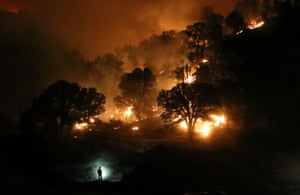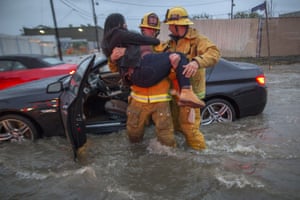By the end of this century, sea level rises alone could displace 13m
people. Many states will have to grapple with hordes of residents
seeking dry ground. But, as one expert says, ‘No state is unaffected by
this’
by Oliver Milman
by Oliver Milman
After
her house flooded for the third year in a row, Elizabeth Boineau was
ready to flee. She packed her possessions into dozens of boxes, tried
not to think of the mold and mildew-covered furniture and retreated to a
second-floor condo that should be beyond the reach of pounding rains
and swelling seas.
Boineau is leaving behind a handsome, early 20th-century house in Charleston, South Carolina, the shutters painted in the city’s eponymous shade of deep green. Last year, after Hurricane Irma introduced 8in of water into a home Boineau was still patching up from the last flood, local authorities agreed this historic slice of Charleston could be torn down.
“I was sloshing through the water with my puppy dog, debris was everywhere,” she said. “I feel completely sunken. It would cost me around $500,000 to raise the house, demolish the first floor. I’m going to rent a place instead, on higher ground.”
Millions of Americans will confront similarly hard choices as climate change conjures up brutal storms, flooding rains, receding coastlines and punishing heat. Many are already opting to shift to less perilous areas of the same city, or to havens in other states. Whole towns from Alaska to Louisiana are looking to relocate, in their entirety, to safer ground.

Boineau is leaving behind a handsome, early 20th-century house in Charleston, South Carolina, the shutters painted in the city’s eponymous shade of deep green. Last year, after Hurricane Irma introduced 8in of water into a home Boineau was still patching up from the last flood, local authorities agreed this historic slice of Charleston could be torn down.
“I was sloshing through the water with my puppy dog, debris was everywhere,” she said. “I feel completely sunken. It would cost me around $500,000 to raise the house, demolish the first floor. I’m going to rent a place instead, on higher ground.”
Millions of Americans will confront similarly hard choices as climate change conjures up brutal storms, flooding rains, receding coastlines and punishing heat. Many are already opting to shift to less perilous areas of the same city, or to havens in other states. Whole towns from Alaska to Louisiana are looking to relocate, in their entirety, to safer ground.

The era of climate migration is, virtually unheralded, already upon America.
This enormous migration will probably take place over a longer period than the Dustbowl but its implications are both profound and opaque. It will plunge the US into an utterly alien reality. “It is very difficult to model human behaviour under such extreme and historically unprecedented circumstances,” Keenan admits.
The closest analogue could be the Great Migration – a period spanning a large chunk of the 20th century when about 6 million black people departed the Jim Crow south for cities in the north, midwest and west.
By the end of this century, sea level rise alone could displace 13 million people, according to one study, including 6 million in Florida. States including Louisiana, California, New York and New Jersey will also have to grapple with hordes of residents seeking dry ground.
“There’s not a state unaffected by this,” said demographer Mat Hauer, lead author of the research, which is predicated on a severe 6ft sea level increase. There are established migration preferences for some places – south Florida to Georgia, New York to Colorado – but in many cases people would uproot to the closest inland city, if they have the means.
“The Great Migration was out of the south into the industrialized north, whereas this is from every coastal place in the US to every other place in the US,” said Hauer. “Not everyone can afford to move, so we could end up with trapped populations that would be in a downward spiral. I have a hard time imagining what that future would be like.”
The projections are starting to materialize in parts of the US, forming the contours of the climate migration to come.
“I don’t see the slightest evidence that anyone is seriously thinking about what to do with the future climate refugee stream,” said Orrin Pilkey, professor emeritus of coastal geology at Duke University. “It boggles the mind to see crowds of climate refugees arriving in town and looking for work and food.”
Pilkey’s new book – Sea Level Rise Along Americas Shores: The Slow Tsunami – envisions apocalyptic scenes where millions of people, largely from south Florida, will become “a stream of refugees moving to higher ground”.
“They will not be the bedraggled families carrying their few possessions on their backs as we have seen in countless photos of people fleeing wars and ethnic cleansing, most recently in Myanmar and Syria,” Pilkey states in his book. “Instead, they will be well-off Americans driving to a new life in their cars, with moving trucks behind, carrying a lifetime of memories and possessions.”
Dejected with frigid New York winters, Chase Twichell and her husband purchased a four-bedroom apartment in Miami Beach in 2011, with the plan of spending at least a decade basking in the sunshine. At first, keeping a pair of flip-flops on hand to deal with the flooded streets seemed an acceptable quirk, until the magnitude of the encroaching seas became apparent when the city spent $400m to elevate streets near Twichell’s abode.
Twichell began to notice water pumps were spewing plastic bags, condoms and chip packets into the bay. Friends’ balconies started getting submerged. Twichell, a poet, found apocalyptic themes creeping into her work. Last year, she sold the apartment to a French businessman and moved back to upstate New York.
“It was like end of the world stuff,” she said. “It was crazy for us to have such a big investment in such a dangerous situation.” Her neighbours initially scolded her but now several are also selling up, fretting that the real estate and insurance markets for properties like theirs will seize up.
A sense of fatalism is also starting to grip some local officials. Philip Stoddard, mayor of South Miami, has seen a colleague, spooked by sea level rise, move to California and some neighbours sell their houses before an expected slump in prices. Stoddard and his wife regularly discuss buying a fallback property, perhaps in Washington DC.
“Most people will wait for the problem to be bad to take action, that’s what I worry about,” he said. “We can buy a lot of time, but in the end we lose. The sea level will go over the tops of our buildings.”
Sanitation is an immediate preoccupation for Stoddard, given the large proportion of residents who aren’t served by sewage works. “If you’re using a septic tank and your toilet starts to overflow into your bathroom because of water inundation, that’s a basis-of-civilization problem,” he said. “A medieval city wasn’t a nice smelling place and they had a lot of diseases.”
Those living near the coasts will face pressures of the gradual (sea level rise) as well as dramatic (storms) nature but people inland will also be harried to move by climate change.
Farming techniques and technology have improved immeasurably since the Dustbowl but rising temperatures are still expected to diminish yields for crops such as maize, soybeans and wheat, prompting the departure of younger people from farming. By 2050, Texas county, the largest wheat-producing county in Oklahoma, could spend an extra 40 days a year above 90F (32C) compared with now.

Meanwhile, cities already struggling with heat will see wealthy residents head for cooler climes. Last year, 155 people died in Phoenix due to a particularly fierce summer. Increasing heat will start testing the durability of the populace, even those shielded by air conditioning. In the western states, wildfires are getting larger, razing homes in ever more spectacular ways and choking thousands of people with carcinogenic smoke.
Further to the south, at the border, there are suggestions that people from Central America are being nudged towards the US because of drought and hurricanes in their homelands, part of a trend that will see as many as 300 million climate refugees worldwide by 2050.
“People will get very grumpy and upset with very hot temperatures,” said Amir Jina, an environmental economist at the University of Chicago who co-authored the research on economic losses. “Even if you have air conditioning, some areas start to look less habitable. By the middle of the century parts of the south-west and south-east won’t look attractive to live in.
“That insidious climate migration is the one we should worry about. The big disasters such as hurricanes will be obvious. It’s the pressures we don’t know or understand that will reshape population in the 21st century.”
Prodded to name refuges in the US, researchers will point to Washington and Oregon in the Pacific north-west, where temperatures will remain bearable and disasters unlikely to strike. Areas close to the Great Lakes and in New England are also expected to prove increasingly attractive to those looking to move.
By 2065, southern states are expected to lose 8% of their US population share, while the north-east will increase by 9%. A recent study forecast that the population in the western half of the US will increase by more than 10% over the next 50 years due to climate migration, largely from the south and midwest.
But these population shifts are uncertain and are bound by a tangle of other factors and caveats. People will still largely follow paths guided by nearby family or suitable jobs. Even those who do want to move may find favoured locations too expensive. Some will just grimly hang on. “With property rights as strong as they are in the US, some people may choose to go down with the ship,” said Harvard’s Keenan. “The question is whether they have the means and the options to do anything else.”
“People can usually cope with being a little less comfortable, but if you see repeated storms or severe damage to crops, that will trigger change,” said Solomon Hsiang, who researches how climate change will affect society at the University of California.
“There will be pressure to move a little north. It won’t be everyone, though, it won’t be like the great migration of wildebeest in Africa. Whole cities picking up and moving would be hugely expensive.”

Smaller towns are giving relocation a go, however. In 2016, the community of Isle de Jean Charles in Louisiana was the first place to be given federal money to replant itself. The population, situated on an island being eaten away by the sea, is looking to move to a former sugar cane farm 30 miles inland.
“We are called climate refugees but I hate that term,” said Chantal Comardelle, who grew up in the Isle de Jean Charles community.
“We will be the first ones to face this in the modern US but we won’t be the last. It’s important for us to get it right so other communities know that they can do it, too.”
About a dozen coastal towns in Alaska are also looking to relocate, as diminishing sea ice exposes them to storms and rising temperatures thaw the very ground beneath them. One, Newtok, has identified a new site and has some federal funding to begin uprooting itself.
A buyout of damaged and at-risk homes has already occurred in New York City’s Staten Island in the wake of Hurricane Sandy, while certain flood-prone houses in Houston, pummeled by Hurricane Harvey last year, are also being purchased and razed.
But the cost of doing this for all at-risk Americans would be eye-watering. Estimates range from $200,000 to $1m per person to undertake a relocation. If 13 million people do have to move, it seems fantastical to imagine $13tn, or even a significant fraction of this amount, being spent by governments to ease the way.
“As a country we aren’t set up to deal with slow-moving disasters like this, so people around the country are on their own,” said Joel Clement, a former Department of the Interior official who worked on the relocation of Alaskan towns.
“In the Arctic I’m concerned we’ve left it too late. Younger people have left because they know the places are doomed. These towns won’t be relocated within five years and I’m sure there will be a catastrophic storm up there. My hope is no lives will be lost.”
Ultimately, the US will have to choose what it wants to defend and hope its ingenuity outstrips the environmental changes ranged against it. Not everyone will be able to shelter behind fortifications like the ‘big U’ planned to defend lower Manhattan. Wrenching decisions will have to be made as to what and where will be sacrificed.
“We won’t see whole areas abandoned but neighborhoods will get sparse and wild looking, the tax base will start to crumble,” said Stoddard, mayor of South Miami. “We don’t have the laws to deal with that sort of piecemeal retreat. It’s magical thinking to think someone else will buy out your property.
“We need a plan as to what will be defended because at the moment the approach is that some kid in a garage will come with a solution. There isn’t going to be a mop and bucket big enough for this problem.”

No comments:
Post a Comment